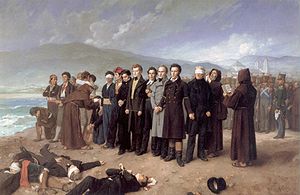
Antonio Gisbert
Encyclopedia

Spanish Eclecticism
Spanish Eclecticism was a movement among Spanish painters from 1845 to 1890. It was named after the tendency by artists to select from among multiple established styles of that era. A sensibility of relative renewal dominated the rest of Europe, while in Spain, Realism and Impressionism were slow...
school of painters. He generally tried to promote liberal
Liberalism and radicalism in Spain
This article gives an overview of liberalism and radicalism in Spain. It is limited to liberal and radical parties with substantial support, mainly proved by having been represented in parliament. The sign ⇒ denotes another party in that scheme...
causes in his politics and paintings.
Early life
Gisbert was born in Alcoy on December 19, 1834. He began his artistic studies at the Real Academia de Bellas Artes de San Fernando in Madrid in 1846, working under José de Madrazo y Agudo.Director of the Museo del Prado
Gisbert became the first Director of the Museo del PradoMuseo del Prado
The Museo del Prado is the main Spanish national art museum, located in central Madrid. It features one of the world's finest collections of European art, from the 12th century to the early 19th century, based on the former Spanish Royal Collection, and unquestionably the best single collection of...
in Madrid
Madrid
Madrid is the capital and largest city of Spain. The population of the city is roughly 3.3 million and the entire population of the Madrid metropolitan area is calculated to be 6.271 million. It is the third largest city in the European Union, after London and Berlin, and its metropolitan...
in 1868. He stayed in that position until 1873, when he moved permanently to Paris. He would die there on November 27, 1901.
Works
- El fusilamiento de Torrijos y sus compañeros en la playa de Málaga ("The Execution of Torrijos and his companions at MálagaMálagaMálaga is a city and a municipality in the Autonomous Community of Andalusia, Spain. With a population of 568,507 in 2010, it is the second most populous city of Andalusia and the sixth largest in Spain. This is the southernmost large city in Europe...
Beach"), his best-known work. It was made in 1888, and resides in the Museo del PradoMuseo del PradoThe Museo del Prado is the main Spanish national art museum, located in central Madrid. It features one of the world's finest collections of European art, from the 12th century to the early 19th century, based on the former Spanish Royal Collection, and unquestionably the best single collection of...
. - Los Comuneros de Castilla ("The Comuneros of Castile", variously translated otherwise as "The Execution of the Comuneros of Castile" or "Comuneros on the Scaffold"), an oil-on-canvas work which he debuted at the Exposición Nacional of 1860 where it won first prize.

